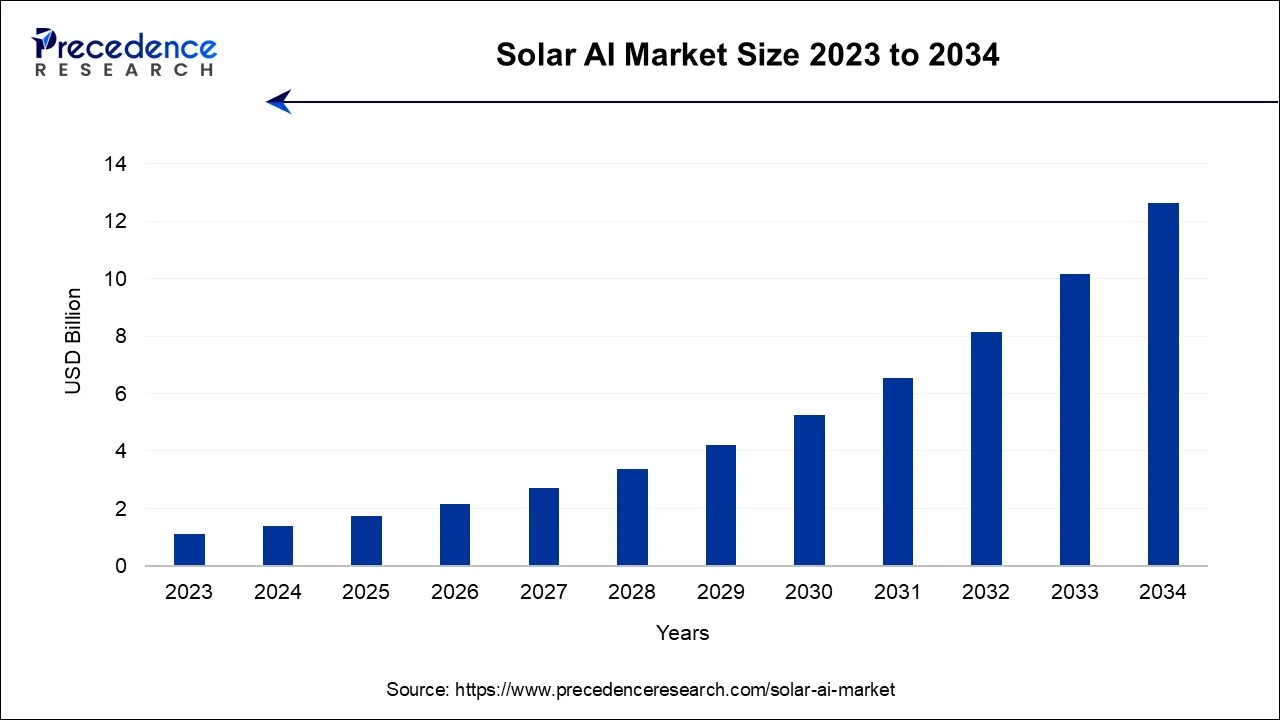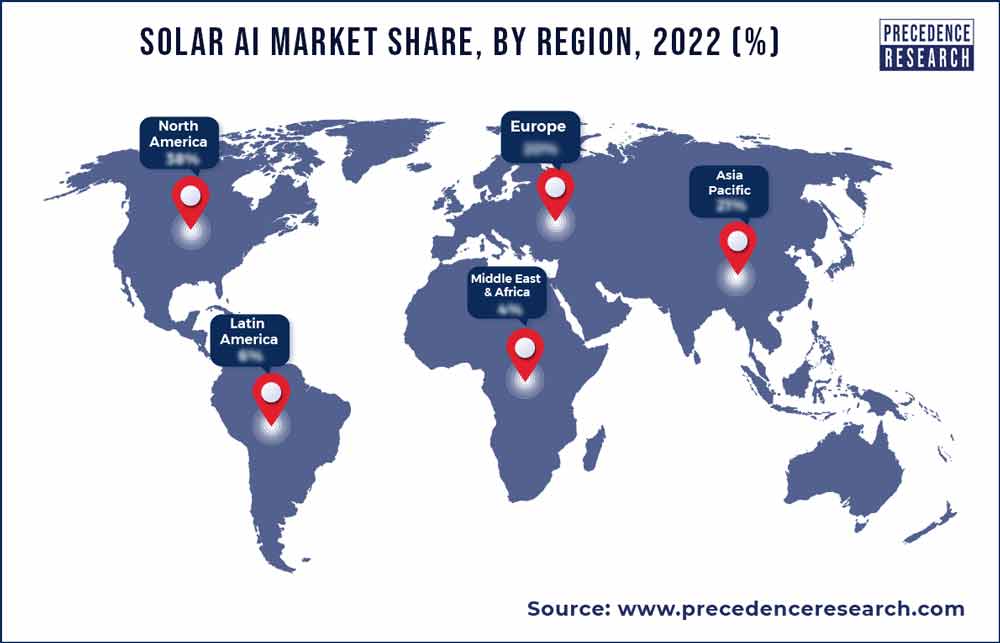August 2024
Solar AI Market (By Technology: Natural Language Processing, Machine Learning, Computer vision, Others; By Application: Energy management, Smart grids, Energy production, Smart meters, Demand forecasting, Others) - Global Industry Analysis, Size, Share, Growth, Trends, Regional Outlook, and Forecast 2024-2034
The global solar AI market is surging, with an overall revenue growth expectation of hundreds of millions of dollars during the forecast period from 2024 to 2034.

The global solar AI market offers solutions for the solar energy industry while utilizing the potential of artificial intelligence technology. The energy industry is evolving rapidly. With such rapid growth, industry continuously seeks innovative ways to revolutionize energy solutions. The adoption of artificial intelligence solutions for the energy industry, especially for the solar industry, has been a boon.
The deployment of artificial intelligence technologies such as machine learning, computer vision, cloud computing and natural language processing can significantly lower emissions by optimizing energy in an efficient and smarter way. The penetration or deployment of artificial intelligence and its powers in solar industry is observed to replace the analytical, physical and empirical models in forecasting, synthesis of data and power flow optimization.
Data and Statistics
Top 5 Solar Countries:
| Sr. No | Country | Solar capacity (installed) | Aims and targets |
| 1. | China | 430 GW (As of April 2023) | Targeted to develop 1200 GW solar and wind energy capacity by 2030 |
| 2. | United States | 3% of country’s electricity is derived from solar presently | Aim to reach 40% of electricity demand from solar by 2025 |
| 3. | Japan | Deployed 6,545.2 MW of new solar capacity in 2022 | Targeted to install solar panels over 50% municipal buildings in the country |
| 4. | Germany | 2.6 GW (in first quarter-Q1 2023) and witnessed a year-on-year growth of 30% | Planned to install solar power capacity of 215 GW by 2030 |
| 5. | India | Witnessed 20.8% year-on-year growth on solar power installation capacity in 2023 | Aimed to create solar power capacity of 280 GW by 2030 |
India-based solar startup, Renkube demonstrated that AI-powered solar panels can increase the energy yield of the panel by up to 20%. This also clarifies that the utilization of artificial intelligence in grid operators can help operators in better and precise decision-making by enhancing the generation of power. This factor is entitled to promote the market’s growth in the upcoming years.
Heliogen has recently integrated an artificial intelligence-powered robotic system to lower the overall installation and maintenance cost of building a solar plant. The offering of predictive maintenance at an effective cost will promote the adoption of artificial intelligence solutions in the solar power industry by acting as a growth factor for the market.
| Report Coverage | Details |
| Largest Market | Asia Pacific |
| Base Year | 2023 |
| Forecast Period | 2024 to 2034 |
| Segments Covered | By Technology and By Application |
| Regions Covered | North America, Europe, Asia-Pacific, Latin America, and Middle East & Africa |
Rising demand of solar power systems in agricultural activities
In June 2023, an agriculture technology start-up, Aigen announced the launch of a scalable robotics platform with AI algorithms. The newly launched platform aims to offer real-time insights for farmers with reduced cost and increased time savings.
There is a significant demand for solar systems in the agriculture sector, solar systems in agriculture can offer a sustainable yet cost-effective source of energy. AI’s capabilities are observed to analyze data from solar-powered sensors and cameras to monitor crop health, soil conditions and weather patterns. Predictive analysis is another major and crucial application of AI-based solar power systems in the agriculture sector. AI can utilize real-time data to predict energy production, crop yields and market trends. This real-time data is observed to empower farmers to plan agricultural activities effectively. Considering these factors, the deployment of AI in solar system is predicted to offer profitable farming practices, contributing to the growth of the market.
Consumer skepticism
Concerns over the long-term reliability of solar system with the deployment of AI-systems can be a major obstacle for the expansion of the market. Consumers may not always fully understand how artificial intelligence integrates with solar power systems. A lack of education on the subject can contribute to the skepticism and reluctance to embrace AI in the solar market. In addition, concerns over data security can hinder the market’s growth. Consumers may be worried about the collection of their energy consumption data. All these factors have the potential for creating skepticism among users.
Renewable energy targets
In September 2023, lawmakers in European countries passed a law to boost the pace of approval for renewable energy projects to curb climate change. On the other hand, the Indian Ministry of New and Renewable Energy stated that it is planning to release new bids to promote renewable energy projects in the country to attain its goals by 2030.
Such renewable energy targets mandate the expansion of clean energy sources, including solar power. This drives the adoption of solar energy systems, creating a larger market for AI solutions. To meet these targets, solar power systems need to be as efficient as possible. Solar AI can reduce downtime and enhance efficiency, helping to achieve these goals. Governments and businesses seek effective ways to reach renewable energy goals. AI deployed in solar power systems can reduce the cost of electricity by maximizing energy production and minimizing maintenance expenses.
The machine learning segment dominated the solar AI market in 2023; the segment is observed to continue the trend throughout the forecast period. Machine learning algorithms excel at processing vast amounts of data generated by solar installations. Machine learning can analyze historical weather patterns and system performance to optimize solar energy production. Machine learning also contributes to cost reduction by optimizing maintenance requirements and reducing downtime.
In February 2023, a group of Dutch scientists at Delft University of Technology developed a PV forecasting method with machine learning models that can detect and analyze the amount of power yield in large solar PV systems, especially installed at residential areas.
Additionally, machine learning can also assess the environmental impact of solar installations by analyzing data and recommending eco-friendly practices. Machine learning algorithms can analyze consumption patterns to help customers make informed decisions about energy usage. The overall performance for enhancing efficiency of solar power systems offered by machine learning models makes the segment attractive in the global market.
On the other hand, the computer vision segment is expected to grow at a significant rate throughout the forecast period. Computer vision technology can enhance security at solar facilities by detecting intruders or anomalies in real-time, ensuring the protection of valuable assets. Computer vision’s ability to analyze visual data and make real-time decisions is poised to revolutionize the solar AI market.
The demand forecasting segment is observed to hold the dominating share of the solar AI market during the forecast period. Artificial intelligence algorithms are capable of predicting how much solar energy is needed for a particular system, this increases energy efficiency by reducing waste. Grid balancing, energy storage and enhancement in consumer engagement are a few factors that lead to the segment’s dominance in the market.
On the other hand, the smart grids segment is expected to generate a notable revenue share in the market. Smart grid in solar power systems is the most emerging application across the global industry. Smart grids allow for the remote monitoring and control of various components in the energy infrastructure. AI can automate decision-making processes in real-time to ensure optimal solar power utilization.
Asia Pacific is expected to witness the quickest rate of growth in the solar AI market during the predicted timeframe; the region is also anticipated to lead the market in upcoming years. Countries in Southern Asia enjoy sunlight throughout the year. The area also heavily practices traditional agriculture activities. The emphasis on the deployment of solar power systems in the agricultural field is observed to boost the demand for advanced technologies, including artificial intelligence. Rising environmental awareness and the requirement to reduce greenhouse gas emissions are driving the adoption of renewable energy sources, including solar power.
According to the report published by Enerdata, the electricity consumption in India increased by 10% in 2023. Meanwhile, the residential power consumption in China rose by 13.8% in 2022. Whereas the total electricity consumption in Singapore increased by 2.6% in 2022. Similarly, multiple Asian countries are witnessing high energy demand.
Artificial intelligence is capable of optimizing the efficiency of solar energy systems, ensuring that power generation is maximized. This factor is observed to be particularly crucial for countries with high energy demands.
China is one of the major contributors to the expansion of solar AI market in Asia Pacific. The country actively promotes research and innovation in the solar power sector. National Key R&D program of China, Fundamental Research Funds for the Central Universities and National Natural Foundation of China are a few programs funded for boosting research and development of AI in energy and power sector.

On the other hand, Norh America is observed to sustain as a significant marketplace throughout the forecast period. The region’s high energy consumption, along with an increasing focus on clean energy, makes it a promising market for solar AI. Multiple governments in North America offer incentives, tax credits and regulatory support for renewable energy projects, including solar. These initiatives encourage investment in solar AI technology.
The initiatives taken by Solar Energy Technologies Office (SETO) in the United States support penetration and development of low-cost and high-efficiency power solutions that make solar power more accessible for both, commercial and residential usage. As of October 2023, SETO has planned to hold a tow-day workshop in Alexandria to offer a broader understanding of solar applications of artificial intelligence and machine learning.
Meanwhile, Europe is growing at a notable rate in the solar AI market owing to the government initiatives that supplement the growth of renewable energy sector in multiple European countries. The German government has established an aim to achieve 215 GW solar pawer capacity by 2030. Europe also carries a number of startups that are focused on research and innovation for the deployment of artificial intelligence in solar power systems. Scopito, Smart Helio, Tespack, Glint Solar and Absolar are a few startups from different European countries.
While applying the power of artificial intelligence in the solar power sector, multiple key players have initiated experimenting with the potential of the advanced technology in recent years. A few of these prominent players are:
Segments Covered in the Report
By Technology
By Application
By Geography
For inquiries regarding discounts, bulk purchases, or customization requests, please contact us at sales@precedenceresearch.com
No cookie-cutter, only authentic analysis – take the 1st step to become a Precedence Research client
August 2024
January 2025
August 2024
January 2025